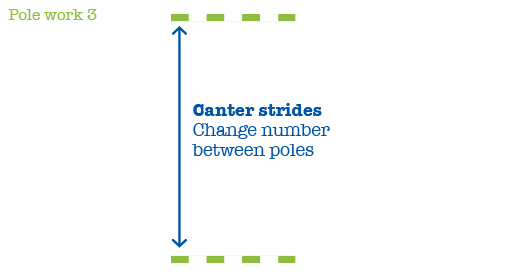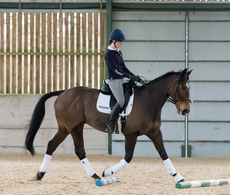
Improve your horse’s performance with polework
Do you want to add some fun to your schooling, while also developing suppleness, balance and responsiveness in your horse and yourself? These polework exercises can help you do just that.
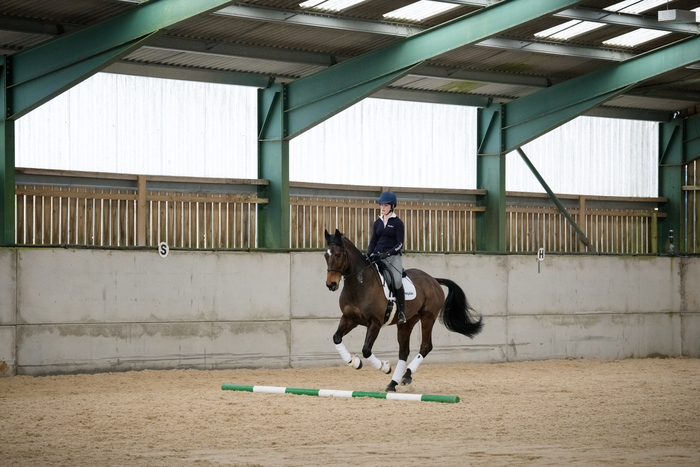
How can polework benefit your horse?
‘As well as making flatwork more exciting, polework develops your horse’s core stability. It also works his top line and improves his suppleness by encouraging him to step under with the hindleg more,’ explains Stef Eardley, a list five dressage judge and British Dressage registered trainer. ‘And polework lets you influence your horse’s stride length. It’s a great exercise if your horse tends to rush, as the poles make his rhythm and stride length more regular,’ she says. ‘For horses with naturally shorter stride lengths, you can set the poles wider apart so he has to stretch and open his frame. On the flipside, if you’re trying to develop more collection, you can shorten the distance between poles so your horse has to collect his stride.’
Working over poles can also encourage your horse to be more agile, as he has to pick his legs up higher to step over the poles. This can be especially helpful if your horse is coming back from injury or needs to build strength and fitness.
Why should you try polework?
‘Polework is good for improving balance, control and steering. It also requires precision, so it can help to refine your aids (and your horse’s reaction to those aids), which benefits everyday riding,’ explains Stef. ‘Your horse will have to focus on where he’s going and what he’s doing, and you’ll have to look up and ahead so you can plan your route. It’s great for riders who tend to look down at their hands.’
For horses with a tendency to be crooked in their body, polework can help to promote straightness. As, even if you’re riding your horse on a circle, you’ll have to stop him from falling in or out through his shoulders or over-bending.
‘During polework, riders should aim to ride over the centre of the pole,’ Stef says. ‘Coloured poles can make this easier, as you can focus on a particular colour in the centre. It’s important to have your horse between your leg and hand, and in front of your leg, and he should be listening to you. You should be able to make minor adjustments and have your horse respond straight away.
‘The great thing about polework is that you can ride as many different shapes and lines as your imagination will allow. Not just over but also around the poles, so you can be quite creative.’
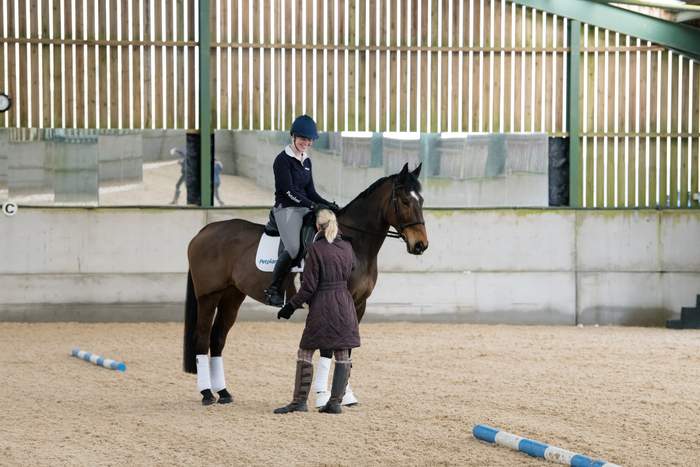
3 polework exercises you can try
Petplan Equine Ambassador Charlotte Wadley and her 11-year-old gelding, Teddy, joined Stef to try out these movements. ‘Teddy often needs reminding to keep his hind legs quick and active,’ Charlotte says. ‘So I was looking forward to trying polework for tips on tackling inaccuracies. I found that it made me think about rhythm in the trot, and helped me recognise when Teddy was dropping behind. It also helped me be more proactive about keeping him together. The exercises were simple but really effective, I’d definitely recommend them.’
1. 10 and 20 metre circles
- Set up four poles, one at each point of a 20m circle (see the diagram below), and trot around the circle aiming for the centre of each pole and for the same amount of strides between each pole. Ensure you have the correct bend on each turn and that your horse’s shoulders and hindquarters don’t fall in or out.
- Keep your horse in a soft outline and working over his back. This is a good way to teach him to accept your aids and the change of bend, while working over his topline and building longitudinal and lateral suppleness. It’s important to maintain engagement, so you don’t lose rhythm and speed.
- You can then ride a 10m circle around each of the poles at the top and bottom of the circle (see diagram). So, as you ride over the centre of the pole on the right rein, turn left and circle 10m back to the pole. Then continue onto the next pole and perform another 10m circle, and so on.
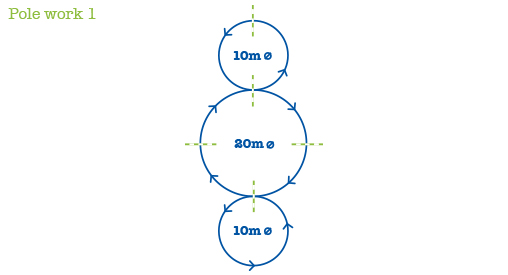
2. Fan of poles
- Set out a fan of four poles on a 20m circle with the poles spaced out at a distance of 4 foot 6 inches (see the diagram below).
- You have three different tracks – an inside, middle and outside track. The inner track requires shorter strides as the distance between the poles is shorter, the middle track should be a natural stride length for your horse and the outside track should encourage slightly longer, wider strides as the poles are further apart. This will allow you to increase and decrease the horse’s stride length while maintaining the suppleness and rhythm. It improves elasticity and suppleness and develops your horse’s pace.
- When asking for shorter strides, sit up and gently half-halt to ask the horse to collect, while keeping your leg on to maintain impulsion. To ask for longer strides, gently put your leg on and rise taller in the saddle, keeping a soft contact on the horse’s mouth.
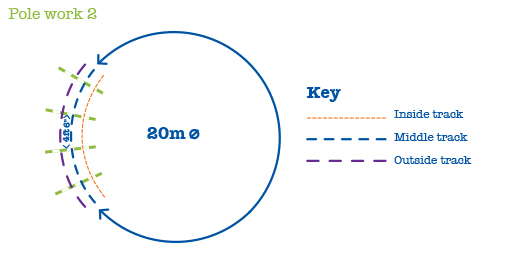
3. Canter stride exercise
- Set out two poles, one at either end of the arena, and canter over them, adjusting the canter strides between the two poles (see the diagram below).
- Start by cantering over the poles in your horse’s natural rhythm and try to repeat this on the way back.
- Now try adding and removing canter strides each time. This is a good exercise for shortening and lengthening your horse’s canter stride. You should be able to adjust your horse’s step without losing rhythm and balance. It’s good for collecting and pushing the horse on; developing engagement and power, while training for adjustability in the canter.
